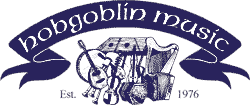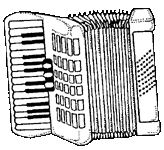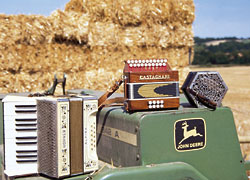
| THE HOBGOBLIN INFO SOURCE | |||
| HOBGOBLIN INDEX PAGE | HOBGOBLIN INFO INDEX | CATALOGUE CONTENTS | ACCORDION ONLINE SALES | SECONDHAND PRICES |
| Accordion FAQ | ||
 |
ON THIS PAGE: Under construction! Accordion background Choosing your Instrument Accordion Makers Accordion Fingering Charts RELATED PAGES: Caring for your Instrument Accordions In Folk Music By Sarah Mallinson |
 |
|
© Copyright Hobgoblin Music 1983, 2000. This text may be freely distributed in whole or in part so long as the copyright holder is clearly acknowledged. Accordion backgroundThe Piano Accordion first appeared about a hundred years ago and initially they were like a melodeon with a piano keyboard, and a limited number of basses. During the 1920ís, great improvements were made to the design and sound, and with the Stradella bass system, a full left hand accompaniment became possible. The Accordion became enormously popular in the 1930ís, and ended the era of the Concertina. While the Accordion is no longer a mainstream instrument, its popularity is growing again. It is very important in traditional music particularly in Scotland. And there are still many accordion bands, marching bands, and accordion competitions. Choosing an AccordionSee also Sarah Mallinson's article on Piano Accordions in Folk The Piano Accordion tends to suit beginners who can already read music or play the piano, as the instrument is very logically laid out, and of course has a familiar keyboard. HOW MANY BASSES?The size of the instrument is usually denoted by the number of basses. These basses are arranged in rows of 6 buttons for each key: counter bass, bass, then major chord, minor, seventh, and diminished. A 120 bass with 41 treble keys is the full size model, and the bass end offers a chromatic scale, and all the chords, arranged in 6 rows of 20. An 80 bass has 5 rows of 16 (omitting the diminished row), and a 37 note keyboard. A 72 bass has a 34 note keyboard, but retains the 6 row bass. The most popular size, and ideal for beginners, is the 48 bass, usually with 6 rows of 8, allowing accompaniment in the keys of Bb, F, C, G, D, & A. The treble keyboard on the 48, 32, and 12 bass models usually has 26 keys, enough for most tunes, but limiting for a pianist. TUNINGS AND OTHER FACTORSMany players have to compromise between portability and range of notes. 48 and 72 bass are the best options for most folk musicians, but you only get the full range of notes, and variety of sound from the registers on a full size 120 bass. Most 2 voice Accordions are tuned with a moderate amount of tremolo, 3 voice have the low octave as well, and musette models have three sets of reeds tuned quite far apart in a strong tremolo, plus a low octave set. Cassotto accordions have an extra sound chamber which changes the sound quality significantly Accordion MakersScarlattiScarlatti Accordions are made in China. They have good reeds, and the accordions are excellent value, although they are not finished to the standards of European makers. The Scarlatti range is ideal for beginners, and they are priced very attractively to enable you to take a chance and see if the Accordion is for you. Scarlatti Accordions come in a range of sizes, and although they are a beginner's instrument, they are of a much higher quality than the Chinese Accordions of the past, and will keep you going for some time! DeliciaDelicia Accordions are made in the Czech Republic, and are reliably made, and well priced. These much improved Czech instruments are the best value in Europe. The reeds are bright sounding and responsive. We recommend these models very highly. Delicia have experimented with a range of sizes and weights to suit different players, and their smaller 72 bass, with reduced keyboard size, has proven extremely popular with accordionists struggling with the weight of a larget instrument, but not willing to compromise on the bass end. SerenelliniExcellent quality accordions with a modernistic style. Craftsman built in Italy. PiginiPigini have been making Accordions since 1946, and use only the finest materials, craftmanship and designs to make these beautiful, professional quality Accordions. We have the Pigini 72 bass P36 3 voice which is simply the best accordion we have ever seen, and the Wing 734 120 bass, which is the lightest 120 bass ever made at only 6.8 kg! Accordion Fingering ChartsBack to the Top of the Page |